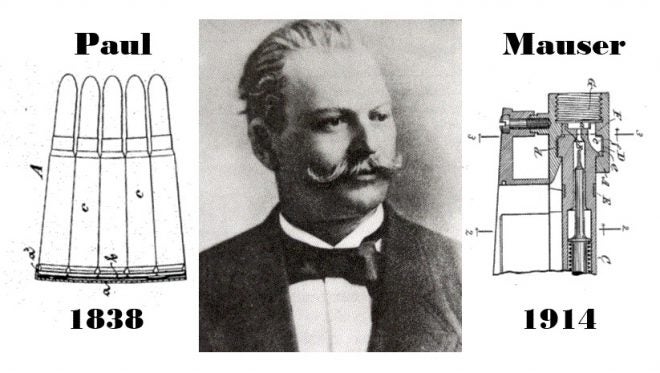A great part of living in the Internet age is that we have far more information at our fingertips than we ever have before. Until recently we had to rely exclusively on books and magazine articles, researched with varying degrees of thoroughness. Some of the information in these has stood the test of time, but some are incorrect. A lot of claims from books and magazine articles have entered the common knowledge, but many of these just aren’t so.
The Mauser series of rifles were some of the most significant front-line military firearms of the late 19th and early 20th centuries, from the 1871 single-shot black powder rifle up to the Kar98k of WW2 German army fame and beyond. The same basic designs still live on little-changed in various hunting rifles still produced today, such as the Winchester 70. Many of the hallmark features of the Mauser series are often cited as being the first example of a particular concept, but as we’ll see below, this isn’t always the case.
- Rimless ammunition
General Julian Hatcher, and others, credit Paul Mauser with the invention of rimless ammunition, where the rim for the extraction of the cartridge does not extend outwards beyond the case body. Edouard Rubin of Schmidt-Rubin fame was also playing around with very modern-looking rimless cartridges in Switzerland at least as early as 1885, probably in parallel with Mauser in Germany, and rimless 7.92mm ammunition was introduced into German military service with the 1888 Commission Rifle.
However, a much earlier patent to George Dupee of the Winchester company (US123622), granted in 1872, shows that the rimless concept was in fact invented in the USA much earlier, in connection with Winchester’s unsuccessful prototype lever-action rifle developments in 1872 and 1873. This project was scrapped in favor of starting again on the basis of the successful 1886 rifle, and as a result, these cartridges did not see the light of day.
An even earlier 1864 patent to John Howe of Worcester, MA (US43851) shows a primitive form of rimless cartridge, although this is clearly less well developed than that of Dupee. The patent states that the groove is used to crimp a case body onto a separate base and to position the cartridge in the firearm, and does not mention its use for extraction. Nevertheless, to modern eyes, it looks very much like a rimless cartridge.
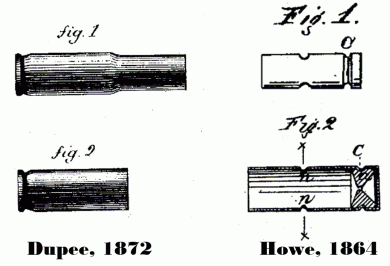
Who knew rimless ammunition had been invented so long ago, and then re-invented a couple of decades later?
- Charger loading
Mauser is almost universally accepted as having been the first to patent the metal strip-type clip that holds on to the rims of the cartridges so that they can be positioned in the rifle and speed-loaded rapidly from the charger directly into the magazine. His US patent on this was filed in 1888 (US402605), and he is often credited with having invented the entire concept of charger loading.
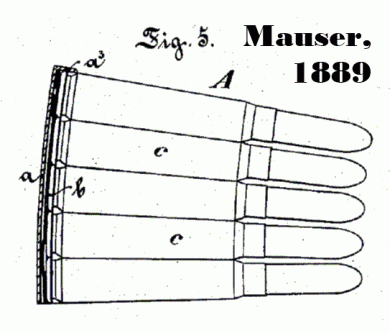
Mauser’s stripper clip that we all know and love.
However, a certain Mr. De Witt Farrington beat him to the punch by about a decade. Farrington was a merchant, inventor, and for a time was treasurer of the US Cartridge Company, based in Lowell, MA. In 1877 he filed a patent (US205180) for a “holder or receptacle for cartridges… from which the cartridges can be readily transferred in a body to the magazine or hopper of a machine or magazine-gun…”, which, aside from a pair of suspending rings on the back, looks very much like a modern stripper clip
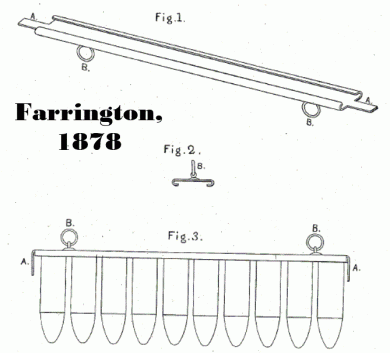
Aside from the rings (and lack of internal spring), this almost 140 year old stripper clip could pass as modern!
Farrington was not the only one to invent a form of charger though. A patent from 1886 to Louis Diss of the Remington company (US356276) shows that Diss also got to the concept before Mauser did. Diss was a prodigious inventor and designer at Remington, and contributed several improvements to the magazine and feed of the Remington-Lee series of rifles, along with many other of the company’s products at the time.

The Diss charger is very similar to the later, more familiar Swiss Schmidt-Rubin type.
The Diss charger is what we would nowadays call a Swiss-type frame charger made of a thin metal sheet or pasteboard for use with a slightly-modified Remington-Lee rifle. This type of charger is known primarily in connection with the Swiss Schmidt-Rubin straight-pull rifles and surrounds the cartridges almost entirely. A thumb slot on the side is left open for pushing the cartridges out from an opening in the bottom and directly into the magazine.
Although the Swiss version of this type of charger saw extensive use, the Diss charger does not appear ever to have been commercialized, and is now mostly forgotten.
- Controlled feed
It seems to be common knowledge that Mauser invented controlled feeding, which ensures that as the cartridge is pushed up out of the magazine by the bolt, its rim hooks itself under the extractor without having to wait until the bolt is fully closed. This prevents accidentally feeding two rounds at once, since a round can already be extracted and ejected before the bolt is fully closed.
Mauser applied for a patent on this feature in 1889 (DE51241, or US476290 in English), and introduced it in the 1893 model, adopted by Spain. Interestingly, this patent still shows a simple, rotating extractor fixed on the bolt head and pre-dates the long, massive claw alongside the bolt body that many people are familiar with today.
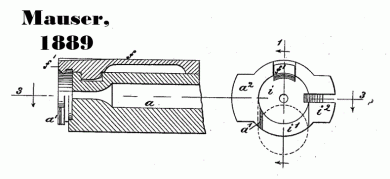
Mauser’s bolt head that appeared on the Model 93 Spanish. Not the extractor at the top, not on the side.
However, controld feed also features in Lee’s 1879 model, patented the same year (US221328), and which features a non-rotating extractor on the right-side of the bolt under which the cartridge rim slips upon feeding. The Lee extractor looks somewhat like a rather smaller version of Mauser’s later large non-rotating claw extractor that appeared from about 1893 onwards. This feature was carried over not only in the rest of the Remington-Lee series, but also into the Lee-Metford adopted by the British military in 1888 and whose action was used with very few changes in the famous Lee-Enfield SMLE, and indeed still lives on in Indian police service today.
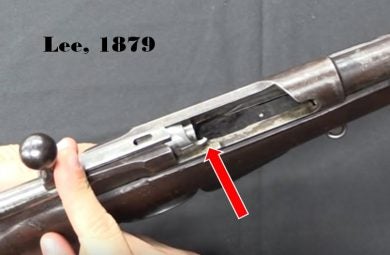
Lee’s extractor is on the right of the bolt head, so a cartridge rim can ride up underneath it on feeding. (c) Forgotten Weapons
- Gas venting / gas management
Whilst it is true that the later Mauser actions are rightly famous for their excellent gas-handling and gas venting in the event of a burst case, which serves to direct escaping gas as safely as possible so as to avoid injury to the shooter and to prevent damage to the rifle, Mauser was not the first deal with the dangers of unwanted gas escape. In fact, the first patent I have found on this topic from him (US579994) was filed as late as 1895.
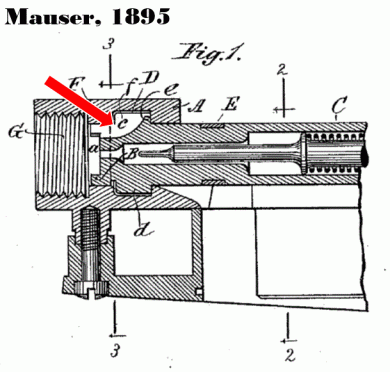
What appears to be Mauser’s first attempts at gas handling, filed 1895.
Again we find that James Paris Lee beat Mauser to the punch. The Remington-Lee 1879 features a convenient gas escape hole on the left-side of the receiver, in front of where the bolt face lies when locked. This allows at least some of the escaping gas to vent out to the left of the receiver, away from the user’s face, in the event of a case rupturing upon firing, and also preventing it from generating a dangerous pressure in the receiver.
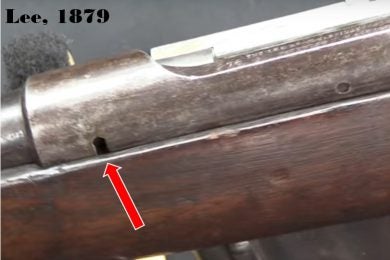
Lee’s gas escape hole on the left of the receiver, more than a decade ahead of Mauser. (c) Forgotten Weapons
The later 1882 and 1885 Remington-Lees also feature a further, extra refinement, namely a gas shield fixed on the bolt head and designed to deflect gas upwards. This ensures that even gas escaping from a case failure that doesn’t make it through the gas escape hole also gets directed away from the shooter.
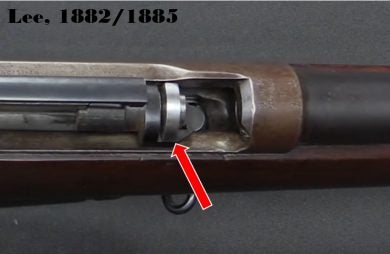
This gas shield was very advanced gas handling for its era. (c) Forgotten Weapons
- Double opposed forward locking lugs
Mauser first introduced a pair of front locking lugs on the Belgian 1889 model of his rifle, and it is one of the features most commonly associated with him, to the point where people often refer to any form of double front locking lugs as being a “Mauser” type bolt. However, by 1889 we have this already in both the M1886 Lebel, and the non-Mauser German 1888 Commission Rifle, from which he was entirely excluded during the design process.
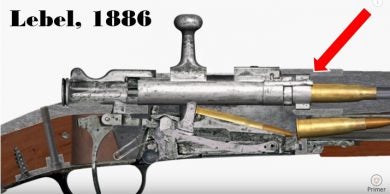
Yes, the French were ahead of the game here with the front lugs. (c) C&Rsenal
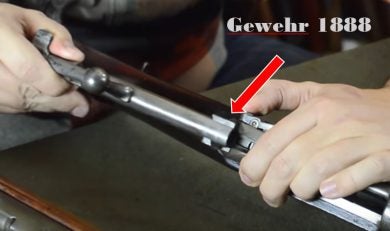
…as were the Germans, but in the absence of Mauser. (c) C&Rsenal
In fact, as late as 1888, Mauser was still working on rear-lockers, such as that featured in the patent US398063 (amongst others), filed that same year.
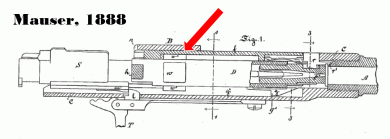
In 1888, Mauser was still all about the rear lugs. Four of them even! The charger-loading patent mentioned above also shows rear-locking.
Conclusion
While not wishing to downplay the very important contributions made by Paul Mauser to bolt-action rifle design, it does not do credit his memory to wrongly attribute to him developments that were not originally his, or which were invented independently by others first. The genius of invention is more often the synthesis and improvement of what has gone before, so as to create something better than the sum of its individual contributions, than it is stamping an entirely original idea out of whole cloth. Of course, it is always possible to define a “first” so narrowly that Mauser can win the crown on any given point of design, or for having been the first to bring it to market, but this devalues the work and talent of other inventors at the time.
With credit and many thanks to Ian of Forgotten Weapons and Othias of C&Rsenal for their kind permission for the use of stills from their videos in this article.
 Your Privacy Choices
Your Privacy Choices
